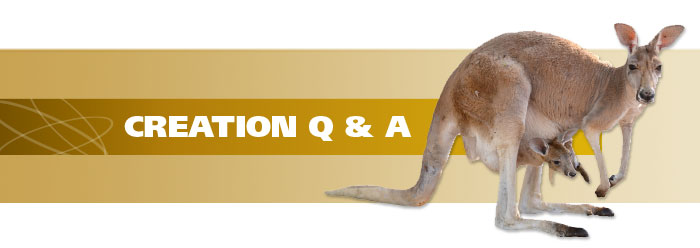About a dozen basic marsupial kinds live across Australia and New Guinea, with a handful in South America. How did they get isolated to those locations? Evolutionists insist that they evolved there, but certain fossils suggest a different answer.
Marsupials include familiar-looking kangaroos and koalas, plus lesser-known bettongs and marsupial moles. Instead of developing in wombs, their young grow inside a mother’s special pouch. What evidence has convinced researchers that marsupials evolved from a single marsupial ancestor in Australia or New Guinea over millions of years?
Whatever the answer is, it’s not fossils, which show just the opposite of this evolutionary story. The lowest and oldest marsupial fossils, found in Cretaceous system rocks, “are exclusively from Eurasia and North America.”1 If Australian marsupials evolved in Australia, then why were their supposed ancestors buried in the opposite (Northern) hemisphere? The “oldest” marsupial fossil, which looks remarkably like an opossum, comes from China.2 A 2003 review admitted, “This geographical switch remains unexplained.”1
What’s worse for this tale is that placental mammal fossils occur in Australian Cretaceous deposits. Australia has long maintained its marsupial populations with very few placentals. But according to the fossils’ locations, marsupials should have evolved far outside of Australia, and placentals should have evolved within Australia—the opposite of evolution’s story.
Overall, fossils show no evidence for marsupial evolution. We see fully formed marsupials or fully formed placentals. Since these marsupial fossils appear only where marsupials do not live today, they must have moved around. But where and when?
Neither a creation-based nor an evolution-believing scientist was there to observe and record when marsupials actually got to Australia, so both must suggest and test scenarios. Some say that Cretaceous marsupials went extinct with the dinosaurs, only for evolution to replace them with exact duplicates millions of years later in Australia! That’s like evolving an opossum once, it going extinct, then natural forces crafting virtually the same creature a second time. Very imaginative, but not very scientific. Fortunately, a Bible-friendly scenario accounts for the fossils without resorting to tales of duplicate evolution.
First, Cretaceous marsupials died in Noah’s Flood. They must have lived in pre-Flood areas that Flood-related events separated into North America, Europe, and Asia.3 The Bible’s eyewitness record of the Flood ensures readers that two of every land-dwelling, air-breathing animal entered Noah’s Ark.4 That included kangaroos, koalas, thylacines, and therizinosaurs.
The Flood caused the Ice Age, which lasted for several centuries.5 Back then, the sea level was about 350 feet lower than it is today.6 Lower seas provided land bridges between many of today’s islands.7 Animals and men could have literally walked from the mountains of Ararat to New Guinea. Some may have rafted on storm debris or swam from islands like New Guinea to Australia.8 If marsupials arrived while the world’s ice was thickest and the sea level was lowest, then melting ice toward the end of the Ice Age would have raised the sea level enough to isolate them on ancient land bridge highlands that became islands.9
Kangaroos and koalas did not evolve in Australia. They did not evolve at all. God made them marsupials from the beginning. Many of them died along with dinosaurs and other creatures in the Flood. Those that survived the Flood on the Ark had descendants that may have migrated ahead of many placental mammals. They probably made it to Australia before rising sea levels virtually stopped placentals from going all the way Down Under. This solution fits the fossils and Scripture.
References
- Cifelli, R. L. and B. M. Davis. 2003. Marsupial Origins. Science. 302 (5652): 1899-1900.
- Luo, Z.-X. et al. 2003. An Early Cretaceous Tribosphenic Mammal and Metatherian Evolution. Science. 302 (5652): 1934-1940.
- Clarey, T. 2013. Hot Mantle Initiated Ocean and Flood Beginnings. Acts & Facts. 42 (8): 15.
- “[Genesis 10:1] is the fourth toledoth of the book of Genesis (previously noted at Genesis 2:4; 5:1; and 6:9), presumably marking the signatures of Shem, Ham and Japheth after completing their narrative of the Flood and the immediate post-Flood years.” Morris, H. 2012. The Henry Morris Study Bible. Green Forest, AR: Master Books, 45.
- Hebert, J. 2013. Was There an Ice Age? Acts & Facts. 42 (12): 20.
- Gomitz, V. Sea Level Rise, After the Ice Melted and Today. Science Briefs. NASA GISS. Posted on giss.nasa.gov January 2007, accessed November 18, 2016.
- Clarey, T. 2016. The Ice Age and the Scattering of Nations. Acts & Facts. 45 (8): 9.
- Even evolutionists have long invoked migration on floating debris mats to explain animal transportation to islands. Similar plant kinds on different continents, flourishing right where ocean currents would have carried them, support rafting.
- Possibly, placentals out-competed marsupials for resources, so marsupials kept migrating to habitats with less competition.
* Mr. Thomas is Science Writer at the Institute for Creation Research.














